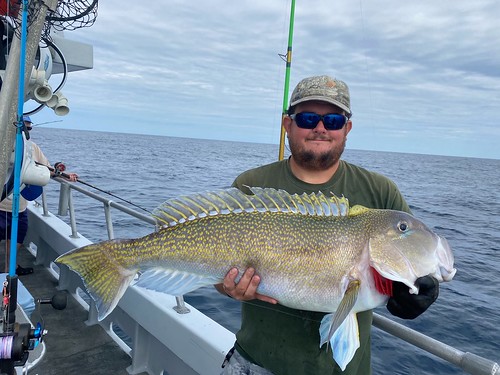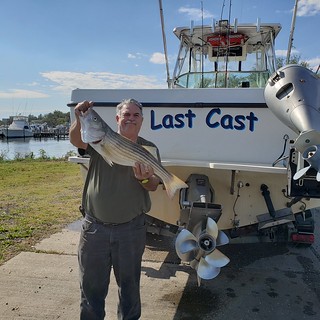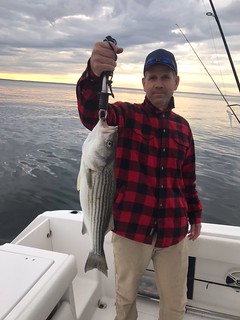
October offshore fishing opportunities include fish such as this beautiful golden tilefish. Photo by Monty Hawkins
Maryland offers a wide variety of fishing adventures this time of year. Many anglers are enjoying the excellent trout fishing or other freshwater species. Fishing for striped bass in the Chesapeake Bay remains at the top of the list for many anglers.
Forecast Summary: October 27 – November 2:
The next few days of cool, windy conditions should complete Bay mixing and provide oxygen down to the bottom. After the winds, Bay conditions should start to stabilize the rest of the week with sunny and calm conditions during the day and cool nights for the week. As the Bay passes this turnover period, surface waters and Bay rivers will cool faster than the bottom waters. As bait moves out of the cooling rivers in search of warmer waters, gamefish will be close behind. Bay surface water temperatures have dropped to the lower 60s.
Improving oxygen and water temperature conditions will continue to provide anglers great opportunities to catch fish in shallower waters and river mouths, ambushing bait moving out of cooler rivers into the warmer main Bay waters. In addition, the traditional places deeper in the water column such as channel edges, underwater points, hard bottom, and drop-offs will also be productive.
There should be suitable oxygen to the bottom in all of Maryland’s Bay waters. Conditions can vary daily and within these areas so be sure to check the depth-to-oxygen level online for your specific location.
Expect normal flows for most Maryland rivers and streams. However, there may be high localized flows as a result of the predicted rains on Friday. There will be above average tidal currents Monday and Tuesday due to the new moon on Nov. 5.
Expect average clarity for many of the Maryland portions of the Bay and rivers, except the Bush, Back, Middle, and Patapsco rivers due to algal blooms. To see the latest water clarity conditions, check Eyes on the Bay Satellite Maps.
For more detailed and up-to-date fishing conditions in your area of the Bay, check the Maryland DNR website for Click Before You Cast. Get regular updates on Maryland’s waters sent to your inbox with our Eyes on the Bay newsletter. Sign up online.
Upper Chesapeake Bay

Ed Narizzano caught this nice striped bass while trolling a spoon in the Brewerton Channel. Photo courtesy of Ed Narizzano
Water conditions have cleared up considerably in the lower Susquehanna, and fishing for striped bass is good. The power generation cycle has been a mix of morning and afternoon water releases. Casting a mix of topwater lures, soft plastics, and paddletails is a popular way to fish the dam pool.
The striped bass action continues downriver near the edges of the Susquehanna Flats during the early morning and evening hours. Casting topwater lures is a great way to fish during these times — paddletails, jerkbaits, and small crankbaits are also popular. Large catfish will also be part of the mix as they tend to chase down these same baits. Casting and jigging is also a good tactic for striped bass at the mouths of the tidal rivers in the upper Bay – the Patapsco, Sassafras, Bohemia, Magothy, and Chester rivers are all good places to fish.
Anglers who can find spot for live-lining are doing well with striped bass at the Bay Bridge and Key Bridge piers. Drifting live eels, small white perch, and fresh-cut baits of gizzard shad and menhaden also works well. Large catfish come into play whenever any kind of bait is lowered into the waters of the upper Bay lately.
Jigging with skirted jigs along channel edges, under breaking fish, and at the Bay Bridge piers is an excellent way to fish for striped bass. Fish spotted on depth finders that are holding near structure can be targeted by casting jigs. The Love Point rocks and Bay Bridge piers also provide good places to work jigs.
Trolling umbrella rigs behind inline weights with bucktails for trailers is a good bet this week along the shipping channel edges and the channels leading from the tidal rivers. Small spoons and rubber hose lures behind planers are also a good choice to reach fish that are suspended off the bottom in deep waters.
White perch are moving onto hard-bottom areas at the mouths of the tidal rivers and also deep shoals and reefs out in the Bay. Fishing with dropper rigs or bottom rigs baited with pieces of bloodworm tend to be the most popular way to fish for them. A mix of blue and channel catfish will be part of the mix whenever any kind of bait is lowered to the bottom. Some anglers are beginning to catch yellow perch in the middle and upper sections of the region’s tidal creeks by casting small jigs and beetle spins.
Middle Bay

Dan Palmer holds up a striped bass from the mouth of the Choptank River. Photo by Michael Clemmer
In this region it is all about striped bass and to a lesser extent bluefish. Now that water temperatures are below 70 degrees the striped bass are being found in a variety of typical fall locations. Primarily they are holding along steep channel edges at the mouths of the tidal rivers and along the edges of the shipping channel. Schools of bay anchovies and juvenile menhaden are exiting the tidal rivers and being swept along by swift current accelerated by the steep channel edges out in the Bay.
The breaking fish action can often be marked by diving seagulls, so keep a keen eye on the horizon and a good pair of binoculars handy. Often the surface action will be made up of smaller striped bass with bluefish also getting in on the action. Larger striped bass often are holding deeper underneath the surface action. Working soft plastics or metal jigs with the help of a fast taper rod and braided line is a good ticket to this show. The mouth of Eastern Bay, the Choptank River, and the Severn River are among the hotspots this week.
Although light-tackle jigging is extremely popular in the fall months, trolling can be a good option as well. Trolling umbrella rigs behind heavy inline weights to get them down to where the striped bass are holding can be a great way to fish. Bucktails are a popular trailer when pulling umbrellas, but small spoons behind planers can work well also. Tandem rigged bucktails or swimshads can be another good option, especially for shallower presentations.
The white perch are moving to deeper waters this week and will be found holding over oyster bars in the lower Choptank, Severn, and Eastern Bay. A watchful eye on a depth finder will help point the way to schools of white perch suspended off the bottom. Pieces of bloodworm on a bottom rig or small jigs on a dropper rig are the most popular ways to fish for them.
There are plenty of catfish to be found in the tidal rivers this week and as the blue crabs exit the rivers and move to Bay waters, fishing for catfish will become easier without crabs nibbling on baits. Channel catfish can be found in all of the region’s tidal rivers, and the Choptank River near the Dover Bridge is holding quite a few blue catfish. The Bill Burton Fishing Pier is an excellent place to fish for white perch, catfish and striped bass this week.
Lower Bay
There is a lot of fishing action in the lower Bay right now. Breaking fish in the form of striped bass and bluefish are being found at the mouths of the tidal rivers and out along the edges of the shipping channel. They are feeding on schools of bay anchovies and juvenile menhaden that are exiting the tidal rivers and heading down the Bay. As these schools of bait exit the rivers, they are swept along by strong tidal currents that occur on the steep channel edges, and this is where striped bass and bluefish will be waiting for them.
The edges of the shipping channel out in the Bay, the mouth of the Nanticoke River and the nearby Tangier Sound, and the lower Potomac and Patuxent rivers are excellent places to find feeding striped bass and bluefish. Casting metal jigs or bucktails to breaking fish always makes for exciting fishing, but jigging underneath the topwater action can pay big dividends in larger fish. There are still some Spanish mackerel zipping through the surface melee and large red drum are being found at times lurking underneath.
In the morning and evening hours, anglers casting a variety of lures including topwater poppers and swimming paddletails are finding a mix of striped bass in various sizes, along with slot sized red drum and speckled trout. The lower Patuxent, the lower Potomac, and the St. Mary’s River on the western side of the Bay are providing good action. On the Eastern Shore, including the Hoopers Island cuts and the tidal areas near the marshes of Tangier Sound, anglers are catching more speckled trout and red drum than striped bass. Casting paddletails or plastic shrimp under a popping cork is a great way to work the grassy areas without fouling lures in the grass.
Trolling is always a good fall fishing option and a great way to cover water in search of fish. Since many of the striped bass and bluefish are suspended off the bottom of the channel edges, it will take inline weights or planers to get lures down to where the fish are holding. Umbrella rigs are pulled behind heavy inline weights to get them down to the fish with bucktails or rubber hose lures as trailers. Spoons and hose lures can often be pulled behind planers without tripping them and offer a good way to get down to the fish. The shipping channel edges near Cove Point and Buoy 72, the HS Buoy, and the channel edge in the lower Potomac from St. Georges Island south to Piney Point are some favorite locations to troll this week.
There is some good fishing for white perch to be found in the lower Patuxent River and Tangier Sound with a scattering of spot and small croaker. The lower sections of the St. Mary’s, the Nanticoke, and the Wicomico rivers are also good places to look for white perch holding over oyster reefs.
Although not completely out of the picture it is becoming harder to put a decent catch of blue crabs together as water temperatures in the tidal rivers drop to the mid 60s. A bright spot is the fact that the crabs that are being caught are large. Depths of 12 feet to 15 feet tend to be where the best catches are being found right now.
Freshwater Fishing

Chuck Vinson holds up a fun-sized smallmouth bass from the Conococheague. Photo by Chuck Vinson
Department of Natural Resources crews have been busy in the past week stocking trout for anglers to enjoy put-and-take fishing experiences. These locations offer a perfect place to take a family fishing since most have easy access and comfortable shoreline fishing opportunities with a simple bobber and bait. Don’t forget good seats, forked sticks to hold fishing rods, and snacks for your younger anglers.
Many of the trout management waters that are set aside for catch-and-release or tackle restrictions have been stocked this month, and will provide excellent catch-and-release trout fishing for the coming months. Be sure to check the trout management maps and listings on the DNR website and get out to some of these waters to enjoy fly fishing or casting artificial lures with spinning gear.
October is perhaps one of the best months to fish Deep Creek Lake. Many of the species that prefer colder water are very active this month. Yellow perch, smallmouth bass and walleye can be found along the deep edges of grass lines and along steep rocky shores – which is also a great place to find walleye in the evening hours by casting small crankbaits and jerkbaits. Northern pike are very active at the mouths of many cove areas, while smallmouth bass can be found near rocky points and sunken wood.
Fishing for smallmouth bass in the upper Potomac is good with the fish taking a variety of small crankbaits, tubes, and craws. Submerged ledges, large boulder pockets, and current breaks are all good places to look for smallmouth bass. Tributaries to the upper Potomac such as the Monocacy and Conococheague also hold smallmouth bass and provide great fishing opportunities.
Fishing for largemouth bass is good, as the fish are very active through most of the day now that water temperatures are cooler. They can be found in a variety of situations from shallow grassy areas to deeper waters near drop-offs and sunken wood areas. Topwater lures and buzzbaits are working well in the shallower areas, often in the sunny afternoon hours when largemouth bass or northern snakeheads are catching a few warm rays of sunshine. A variety of soft plastics and lipless crankbaits will entice largemouth bass holding in transition zones and craws, grubs and crankbaits will cover sunken wood situations in deeper waters.
Maryland State Parks offer outdoor recreation to a wide cross section of the public but they also hold a special place for anglers. Check the DNR website for a list of state parks that offer fishing opportunities for a wide variety of fish species.
Atlantic Ocean and Coastal Bays

photo by Monty Hawkins
Anglers fishing the surf are catching a mix of kingfish, spot, and croaker on pieces of bloodworms. Those using finger mullet or cut spot are catching some bluefish, and a few large red drum are rewarding anglers using large cut baits now and then. Most of the large red drum have moved through the region but there are always stragglers, and a few striped bass are also being caught this week.
At the inlet and Route 50 Bridge area there are striped bass being caught by anglers casting bucktails and soft plastic jigs near the jetty rocks. A fair percentage of the striped bass are coming up short of the 28-inch minimum, but some legal-sized fish are being caught. Bluefish are part of the mix and some weigh as much as 5 pounds or more. Flounder are moving through the inlet and are being caught on Gulp baits as well as squid and minnows. A few tautog are beginning to show up around the South Jetty and the Route 50 Bridge and are being caught on sand fleas and pieces of crab.
Flounder fishing in the channels leading towards the inlet remains good, as long as winds remain relatively calm and the bay does not get stirred up. As bay waters cool, flounder can be expected to be found moving towards the inlet for their exodus to offshore waters in the coming weeks.
Outside the Ocean City Inlet, the fishing for sea bass at the wreck and reef sites is very good, with flounder becoming a larger part of the mix being caught. Farther offshore at the canyons, the yellowfin tuna bite is showing signs of slowing down as catches are becoming spotty. Most are still being caught by chunking with butterfish baits or by jigging with butterfly jigs. Deep-drop fishing for blueline and golden tilefish is good this week for those fishing for them.
“All things are connected. Whatever befalls the earth befalls the children of the earth.” — Chief Seattle
Maryland Fishing Report is written and compiled by Keith Lockwood, fisheries biologist with the Maryland Department of Natural Resources.
Click Before You Cast is written by Tidewater Ecosystem Assessment Director Tom Parham.
This report is now available on your Amazon Echo device — just ask Alexa to “open Maryland Fishing Report.”
